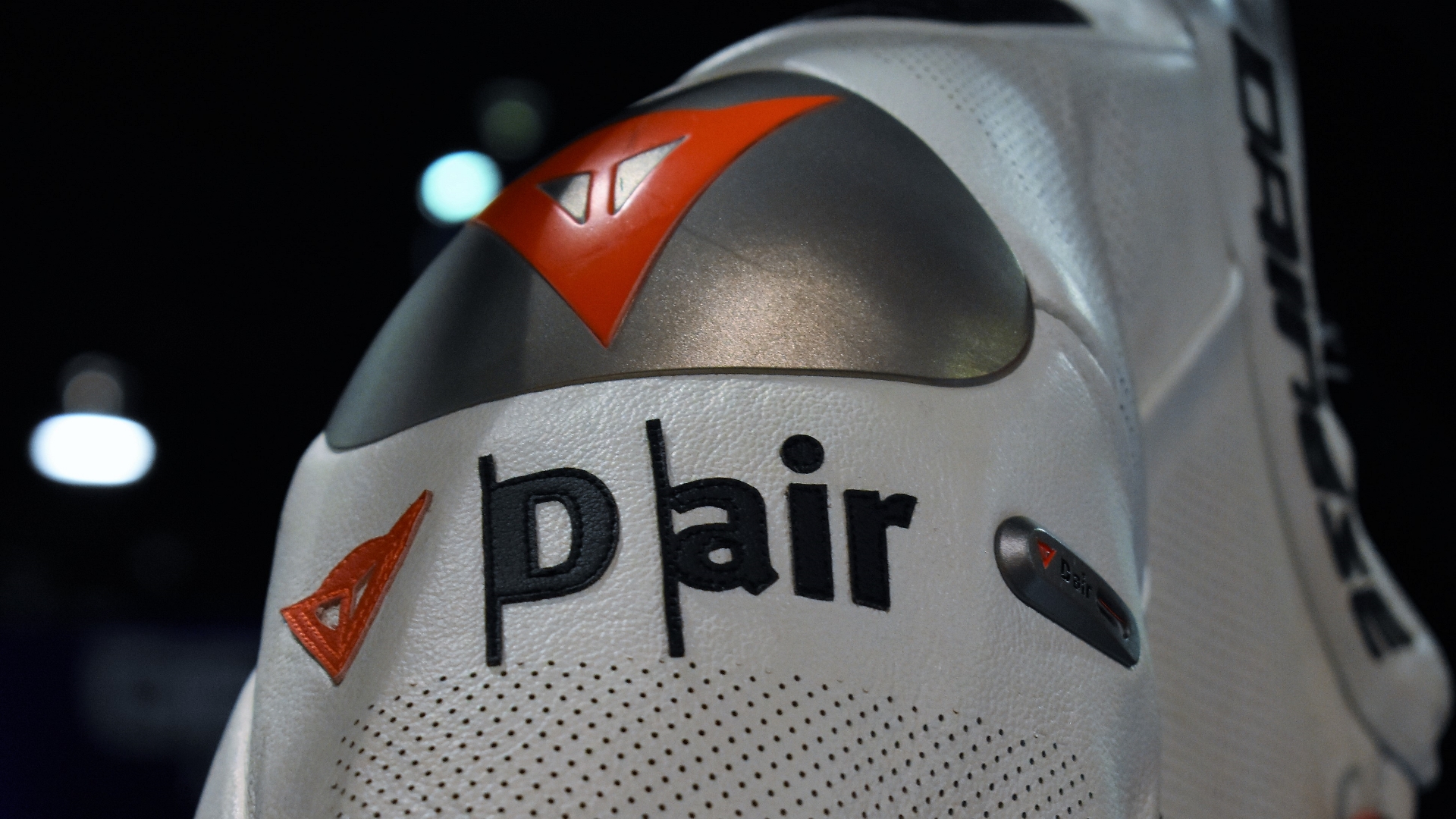

We may earn revenue from the products available on this page and participate in affiliate programs. Learn more ›
The Dainese D-air airbag system has been in the works in one form or another since 2000. It’s safety technology that consists of wearable airbags that deploy in the event that a rider falls off the bike for extra protection reducing the chances of injury.
At the IMS Chicago Motorcycle Show, I had a chance to speak with Dainese USA Marketing Manager Peter Bacon about this impressive safety tech and how it applies to the current product lineup.

“D-air is a project that started at the MotoGP level,” said Bacon. “Like everything we do, it starts at the highest level in MotoGP. Whenever we make a new product for MotoGP, we try to translate that into everyday riding.”
We walked over to a full racing suit used in MotoGP that is available for any motorcycle racer to purchase. “The racing suit has been on the market since 2015,” said Bacon. “What we quickly realized was that this safety should be accessible for everyday riding. Now we have the first standalone D-air jacket.” What he means by “standalone” is that it can be worn on any bike and still work. With earlier versions of this technology, you needed the jacket to be tethered to your bike for the airbag system to work. With current D-air technology, the system operates without any physical connection to the motorcycle.
So how does it work? “How it understands if it’s going to go off is three gyroscopes and three accelerometers plus a GPS,” explained Bacon. “All of those talk to each other about 1,000 times per second. When they all trigger and find something wrong, that’s when it deploys.”
Full inflation takes about 45 milliseconds. That’s literally more than four times faster than the blink of an eye. “A question we get a lot is ‘is it going to go off in time?’ and the answer is always ‘yes.’”
“The GPS is how it understands that you’re actually moving,” said Bacon. The GPS measures your speed so if you just drop the jacket, it won’t deploy because it will know the jacket isn’t moving fast enough to be in a serious accident. “You have to be going about 30 mph for it to deploy.”


So, you can get D-air in a racing suit, but what about regular everyday street riding? “In the jackets, we offer a Gore-Tex version and a leather, more sporty, aggressive version. We also have an urban version a little bit more geared toward the scooter market, but that’s not very common here,” said Bacon noting the popularity of the urban version in Europe.
The D-air jackets available right now are the Gore-Tex Continental jacket and the Misano leather jacket. Both of these high-tech riding jackets cost $1,699.95.
There are a few differences in the D-air system between street and racing applications. The street version focuses more on protecting the vital organs in your chest while the racing version has better protection for the rider’s collarbone and rib cage. “The most common injury in MotoGP racing is collarbone injuries,” said Bacon. “It takes eight pounds of pressure to break your collarbone. If you break your collarbone you usually miss a race and that’s one of the reasons this was invented. If a MotoGP racer misses a race, it can take them out of contention for the season. They’ve been known to race with broken collarbones.”

Next, we discussed CE ratings (European Conformity which signifies that products sold in the EEA have been assessed to meet high safety, health, and environmental protection requirements) and how they relate to D-air. “CE ratings basically measure the amount of energy that is exerted into a material to the other side,” said Bacon. “So with CE level 1, you’ll get 35 kilonewtons [7,868 pound-force] through the material. CE level 2 is about 23 kilonewtons [5,171 pound-force]. That’s usually used for rigid back protectors. With D-air we measure 2 kilonewtons [450 pound-force].”
In other words, D-air has been designed to be much more protective than it even needs to be. 2 kilonewtons (450 pound-force) is barely any force at all and Dainese managed to get that number so low thanks to some very high-tech material in these airbags. It’s a lot more than just a balloon that pads the blow.
“There are 35 different patents on our system and this one is probably the most important,” said Bacon. It’s what Dainese calls microfilaments. It’s a series of millions of filaments that attach to both sides of the inside of the bags. These allow the air distribution to be equal. If you push on a balloon, it sinks in and transfers the pressure to the other side. With D-air, the microfilaments absorb the impact with almost none of the impact reaching the rider. “This allows consistency throughout the entire bag when it’s inflated. When it goes off, it all stays equal,” said Bacon.

If you want serious MotoGP levels of protection in your everyday riding, the Dainese D-air system is a good way to go. The fact that you have a choice between leather and Gore-Tex means there’s a D-air jacket suitable for just about every style of riding.
